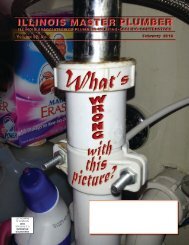IllInoIs PHCC MeMbers by CoMPAny - Illinois Plumbing Heating ...
IllInoIs PHCC MeMbers by CoMPAny - Illinois Plumbing Heating ...
IllInoIs PHCC MeMbers by CoMPAny - Illinois Plumbing Heating ...
You also want an ePaper? Increase the reach of your titles
YUMPU automatically turns print PDFs into web optimized ePapers that Google loves.
Insect Bites and Stings FactSheet<br />
Continued...<br />
may attack with little warning: after firmly grasping the<br />
victim’s skin with its jaws, the fire ant arches its back as<br />
it inserts its rear stinger into the skin. It then pivots at the<br />
head and may inflict multiple stings in a circular pattern.<br />
Fire ant venom often causes an immediate burning<br />
sensation.<br />
Signs and symptoms of an insect bite result from<br />
the injection of venom or other substances into the<br />
skin. The venom triggers an allergic (immune) reaction.<br />
The severity of the reaction depends on the victim’s<br />
sensitivity to the insect venom or substance.<br />
Most reactions are mild, causing little more than an<br />
annoying itching or stinging sensation and mild swelling<br />
that disappear within a day or so. A delayed reaction may<br />
cause fever, painful joints, hives and swollen glands.<br />
A worker can experience both immediate and delayed<br />
reactions from the same bite or sting.<br />
Emergency Care for Victims with<br />
Mild Reactions<br />
Move to a safe area to avoid more insect stings.<br />
Scrape or brush off the stinger with a straight edged<br />
object, such as a credit card or the back of a knife. Don’t<br />
try to pull out the stinger with tweezers or with fingers.<br />
n Wash the area carefully with soap with water.<br />
n Do this two to three times a day until the skin heals.<br />
n Swab the site with disinfectant.<br />
n To reduce pain and swelling, apply ice or a cold pack.<br />
n Apply 0.5 percent or 1 percent hydrocortisone cream,<br />
calamine lotion, or a baking soda paste to the bite or<br />
sting several times a day until the symptoms subside.<br />
n Take an antihistamine containing diphenhydramine<br />
or chlorpheniramine maleate.<br />
Emergency Care for Victims with<br />
Severe Reactions<br />
Severe reactions may progress rapidly. Dial 911<br />
or call for emergency medical assistance if the worker<br />
experiences any of the following signs or symptoms:<br />
n difficulty breathing;<br />
n swelling of the lips or throat;<br />
n faint;<br />
n confusion;<br />
n rapid heartbeat;<br />
n hives; or<br />
n nausea, stomach cramps, and vomiting.<br />
n A sting anywhere in the mouth warrants immediate<br />
attention<br />
While Waiting for Emergency<br />
Transportation<br />
n have the person lie down;<br />
n watch for and treat signs of shock;<br />
n if the person is unconscious and breathing, lay the<br />
person on his or her side to allow drainage from the<br />
mouth; if there’s no pulse, begin cardiopulmonary<br />
resuscitation (CPR); and<br />
n check to see if the person is carrying an allergy<br />
kit containing injectable epinephrine and follow<br />
instructions on the kit.<br />
Less severe allergic reactions include mild nausea<br />
and stomach cramps, diarrhea, or swelling larger than 2<br />
inches in diameter at the site. Recommend the worker see<br />
their physician promptly if they experience any of these<br />
signs and symptoms.<br />
Remember that injectable epinephrine is rescue<br />
medication only, and the worker must still have someone<br />
take them to an emergency room immediately if they are<br />
stung. Additional medical treatment may be necessary.<br />
Workers with severe allergies may want to consider<br />
wearing a special bracelet or necklace that identifies<br />
the wearer as having severe allergies and supplies other<br />
important medical information.<br />
Preventing Stings<br />
Stay out of the “territory” of the stinging insects’<br />
nests. These insects are most likely to sting if their homes<br />
are disturbed, so it is important to have hives and nests<br />
around the workplace destroyed. Since this activity can<br />
be dangerous, a trained exterminator should be hired.<br />
If a worker encounters flying stinging insects, instruct<br />
them to remain calm and quiet, and move slowly away<br />
from them. Many stinging insects are foraging for food,<br />
so don’t smell like a flower – avoid brightly colored<br />
clothing and perfume when outdoors. Because the smell<br />
of food attracts insects, be careful when cooking, eating,<br />
or drinking sweet drinks like soda or juice outdoors. Keep<br />
food covered until eaten. Wear closed-toe shoes outdoors.<br />
Also, avoid loose-fitting garments that can trap insects<br />
between material and skin.<br />
18 <strong>Illinois</strong> Master Plumber, July 2013





